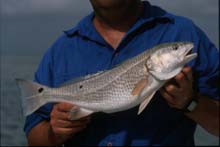
The Saltwater Magazine for Gulf Coast Fishing!

The Bay Naturalist
"The Drum Line"by John Hook
Winter 2005 -(The Bay Naturalist is a regular department in each issue of
Gulf Coast Fisherman magazine.)
![]()
The bay is a noisy place. Gull laughter
blends with water sloshing against boat  hulls, outboard
whines and my favorite, the sound of wind singing across tightly stretched
monofilament accompanied by the staccato strains of a complaining drag.
And that's just what's happening above the water. Down below it's a continuous
symphony dominated by the percussion section, we just don't get to hear
it very often. From time to time a grunt, croaker or redfish will perform
when caught so we know the drum line is a part of the orchestra. But, those
cameo appearances are just a very small part of the clicks, grinds, grunts
and booms that are constantly performed under the water.
hulls, outboard
whines and my favorite, the sound of wind singing across tightly stretched
monofilament accompanied by the staccato strains of a complaining drag.
And that's just what's happening above the water. Down below it's a continuous
symphony dominated by the percussion section, we just don't get to hear
it very often. From time to time a grunt, croaker or redfish will perform
when caught so we know the drum line is a part of the orchestra. But, those
cameo appearances are just a very small part of the clicks, grinds, grunts
and booms that are constantly performed under the water.
Since sound waves travel so much more quickly and efficiently in water than in air it shouldn't be a big surprise that sound plays an important role in marine environments. Most people are aware of the songs performed by migrating humpback whales, and that porpoises and dolphins use sound waves for echolocation. However, the stranger acoustic events that happen in the bay daily don't get the same amount of publicity.
Territorial toadfish booms come from organs so developed that they can be removed from the fish and produce sound when hooked up to batteries. Snapping shrimp create pops with their large claws that are so devastating that the sound waves immobilize their prey. What a deal, snap your fingers and lunch is served! While most examples are not quite as weird as these two, they are still intriguing. Marine scientists know that sound is used by many animals to attract mates, establish territory and catch food. The source of some of the other noise made down there is not as obvious. In fact, most of the "whirrs", "clicks" and "grinds" frequently heard in bay water come from unknown artists.
Fishermen have been taking advantage of the compatibility between sound and water for a long time. Popping corks, rattling plugs and top-water propellers have been around forever and are all designed to take advantage of fish feeding responses to certain noises.
Anyone who has spent any time at all on the bay has heard the unmistakable pop of specks chasing bait on the surface. Obviously, a popping cork is designed to mimic that distinctive sound with the hope that it will trigger a competitive response from other fish in the area. It frequently does, but unfortunately other less desirable species speak speck, too. Hardheads, skipjacks and pinfish respond very well to surface pops, slurps and gurgles. Tackle companies constantly tweak their designs to try and come up with a popping cork that attracts more keepers and fewer undesirables. All of this effort has produced corks that not only pop, they click and snap as well. These added sounds are designed to be similar to those made by fleeing shrimp and baitfish. Whether these added sounds attract more trout is debatable but there is no question that they still attract trash fish.
Feeding noises created by disturbing the water aren't the only sounds that fish make. Different species of fish make distinctive mate attraction noises by rubbing or vibrating their muscles against their swim bladders. This action makes noises just like you would make by rubbing your fingers on a balloon. The swim bladder is also closely linked to the fish's ear bones making it a listening as well as a talking device. Specks, reds, black drum, croaker and spot all use this communication system to call in mates so it makes sense that biologists named this group the "drum" family. To take advantage of this flirtatious chatter we could forget about trying to call in fish using general feeding noises and concentrate on calling up lovesick trout and reds using their particular mating calls. Of course, even if this attracts more fish, they probably wouldn't have feeding on their minds. But you never know, it just might work.
Other species make distinctive noises by grinding their teeth, usually using the crushing teeth back in their throats. Snapper, sheepshead and grunts all use this sound production method. These noises are associated with feeding, mate attraction and possibly schooling communication. Who knows, maybe the next time you take a snapper trip the deckhand will attach a noisemaker to your double drop bottom rig.
The importance of sound in determining how our bays work is still very
poorly known. In many ways we have not advanced very much past the "popping
cork" level of understanding. We do know that sound is used in many
ways by nearly every animal species, but how it all ties together is still
unclear. Considering the strong connection between popular bay species and
underwater noise it is quite likely that fishermen will play a large part
in discovering exactly how the drum line fits into the bay orchestra.
Home | More Articles
